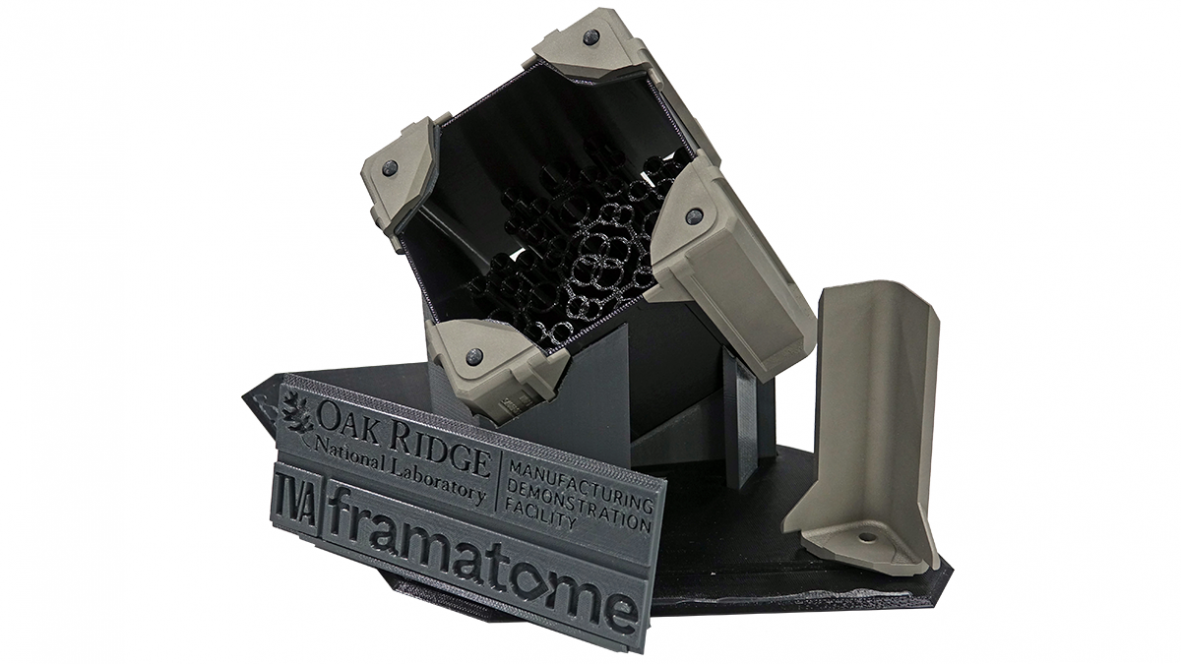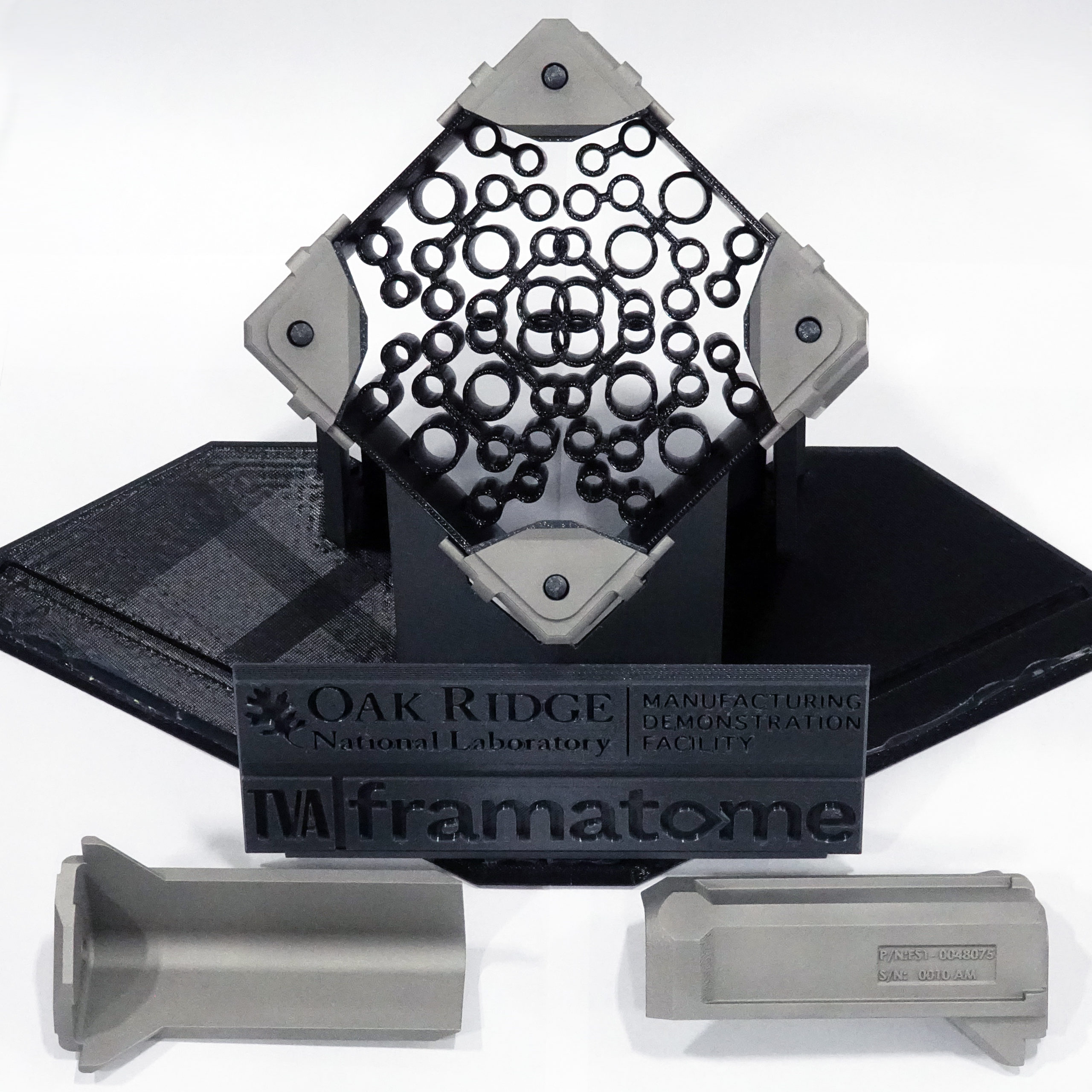While researching some of the most exciting aspects of 3D printing technology, Oak Ridge National Laboratory is also delivering some very interesting 3D printed parts to some notable users. The most recent are the U.S. Tennessee Valley Authority (TVA) and France’s Framatome, who commissioned the Department of Energy lab to develop a set of four brackets for use at the Browns Ferry Nuclear Power Plant. The metal 3D printed brackets will be installed at the site in Spring 2021, becoming the first of their kind to be used in a commercial reactor.
Located on the Tennessee River near Athens, Alabama, the Browns Ferry plant was the largest in the world at the time of its initial operation in 1974. It was also the first to generate over one gigawatt of power. Nearby Wheeler Lake along with seven fan towers cool the site’s three General Electric boiling water reactors, which produce almost 3.8 gigawatts of energy. This makes it the second most powerful nuclear plant in the U.S. and the most powerful run by the TVA.
As of 2019, Browns Ferry has seen a series of new upgrades that increase the facility’s output by 14.3 percent. In 2021, it will see yet another, albeit comparatively small, upgrade of the additive kind. As a part of ORNL’s Transformational Challenge Reactor (TCR) program, the lab was charged with 3D printing channel fasteners for a boiling water reactor fuel assembly made by Framatome, TVA’s fuel supplier. The components secure the fuel channel to the boiling water reactor fuel assembly, with the fuel channel wrapping around the assembly and directing coolant through the fuel rods.
 3D printed fasteners made by ORNL for the Browns Ferry plant. Image courtesy of Fred List/ORNL, U.S. Dept. of Energy.
3D printed fasteners made by ORNL for the Browns Ferry plant. Image courtesy of Fred List/ORNL, U.S. Dept. of Energy.Using a micro-welding process, the parts were 3D printed to comply with reactor safety regulations. 3D data captured during the printing process, which detail every layer of the print, have also been provided so that the quality of the parts can be certified. In the past, traditionally made fasteners were made from expensive castings and necessitate precision machining. Additive manufacturing (AM), in this case, was a more efficient way to create the parts.
The TCR program is meant to introduce new manufacturing methods to industry partners as a means of speeding up the development of nuclear systems. Because the brackets are key to the fuel assembly, they serve as a useful demonstrator for the capabilities that 3D printing can bring to the nuclear power sector. In turn, additive manufacturing may be used to fabricate more complex parts for nuclear power applications in the future.
“This is one of the first steps in ORNL’s coordinated efforts with the Nuclear Regulatory Commission’s Office of Regulatory Research and the nuclear vendors to prove that a new and greatly accelerated approach for qualified part fabrication is possible,” said TCR Director Kurt Terrani.
Framatome began exploring AM for nuclear fuel applications in 2015 with a focus on stainless steel and nickel-based alloys for fuel assembly parts. Its experts then worked closely with customers and relied on funding from the European Union and DOE to push the technology further.
 These fuel assembly brackets, manufactured by ORNL in partnership with Framatome and Tennessee Valley Authority, are the first 3D-printed safety-related components to be inserted into a nuclear power plant. Image courtesy of Fred List/ORNL, U.S. Dept. of Energy
These fuel assembly brackets, manufactured by ORNL in partnership with Framatome and Tennessee Valley Authority, are the first 3D-printed safety-related components to be inserted into a nuclear power plant. Image courtesy of Fred List/ORNL, U.S. Dept. of EnergyThe use of AM for this application is an obvious choice, given 3D printing’s strong value proposition for high-cost, low-quantity parts. As a technology easily capable of producing complex geometries in small numbers at prices that are competitive with traditional manufacturing techniques, AM is ideal for such industries as nuclear, aerospace, and motorsports. It can be used not only to make better performing parts for cheaper, but with a shorter turnaround time as well.
For this reason, we’ve seen numerous projects apply 3D printing to the production of nuclear reactor parts. While Idaho National Laboratory uses the technology to fabricate parts for its research endeavors, the University of Pittsburgh was awarded $1 million to study the 3D printing of components for nuclear reactors. In 2017, Siemens had already installed a 3D printed part in a nuclear reactor, which pushed Westinghouse to pursue a similar initiative. There are even projects underway to use 3D printing for recycling nuclear fuel and even nuclear fusion (the highly sought-after energy technology that is the opposite of the fission that powers existing nuclear power plants).
The fasteners have already been installed on ATRIUM 10XM fuel assemblies at Framatome’s nuclear fuel manufacturing facility in Richland, Washington. In March 2021, the new brackets will be installed on Browns Ferry 2 during a scheduled refuelling outage and will stay there for six years as the parts are inspected throughout their use.
Subscribe to Our Email Newsletter
Stay up-to-date on all the latest news from the 3D printing industry and receive information and offers from third party vendors.
Print Services
Upload your 3D Models and get them printed quickly and efficiently.
You May Also Like
Heating Up: 3D Systems’ Scott Green Discusses 3D Printing’s Potential in the Data Center Industry
The relentless rise of NVIDIA, the steadily increasing pledges of major private and public investments in national infrastructure projects around the world, and the general cultural obsession with AI have...
Formlabs Teams Up with DMG MORI in Japan
In late June, Nick Graham, Chief Revenue Officer at Formlabs, announced on LinkedIn that the company had partnered with DMG MORI, one of the world’s leading machine tool companies, to...
EOS in India: AM’s Rising Star
EOS is doubling down on India. With a growing base of aerospace startups, new government policies, and a massive engineering workforce, India is quickly becoming one of the most important...
3D Printing News Briefs, June 25, 2025: R&D Materials, 3D Printed Veneers, & More
In today’s 3D Printing News Briefs, 3DXTECH has launched a program that gives customers early access to experimental materials, and the first Lithoz CeraFab Multi 2M30 in the Czech Republic...



































